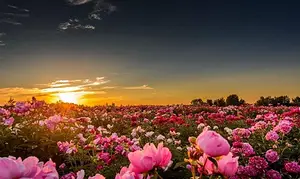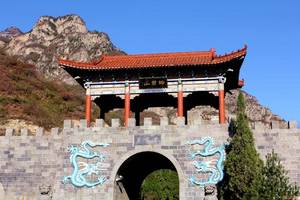Millennium ancient Tang Dynasty hot spring in Fengxiang, Luoyang
1 cities |
5 attraction(s) |
total distance 19
km
 TIPS
TIPS
Day1
Day2
Day1: Luoyang
1 attraction(s) ·
0 km
1
Luoyang Longmen Fengxiang Hot Spring Tourist Resort is located at the southern end of Luoyang Wangcheng Avenue, adjacent to the Yichuan North exit of the Zheng Shaoluo Expressway, with convenient transportation. The resort is a high-quality leisure and vacation complex with hot spring health as its main theme, covering an area of over 1,000 acres. It integrates outdoor health hot springs, cultural theme dining, ecological agricultural sightseeing, and entertainment and fitness.
Day2: Luoyang
4 attraction(s) ·
19 km
1
It is said that Laozi, the founder of Taoism in the Eastern Zhou Dynasty, once lived and practiced here, which is why the mountain was named Laojun Mountain. It is the main peak of the Funiu Mountains and has an altitude of over two thousand meters, with many official temples and shrines. In ancient times, it was regarded as a sacred place of Taoism. Of course, there are also local specialties for sale in the scenic area, as well as famous landmarks such as the statue of Laozi riding a cow and the golden statue of Taishang Laojun.
8
km
2
Laozi Cultural Park is located at the north foot of Fenghuang Mountain in Gaokai District, Nanguan District, Luoyang City, Henan Province, China. It is a cultural scenic area with Laozi as the main theme. The park covers a large area and includes large-scale sculptures, cultural squares, museums, and other leisure facilities.
Laozi Cultural Park is a national-level intangible cultural heritage protection base supported by the Chinese government. The core of the park is the "House of Laozi," which is a museum that showcases the history and culture of Laozi and his philosophical thoughts. The museum houses a large number of historical artifacts and research materials related to Laozi, equipped with multimedia devices and exhibition halls, making it easier for visitors to understand the connotation of Laozi culture.
One of the most striking attractions in Laozi Cultural Park is the Laozi Square, which consists of a 7.5-meter-tall bronze statue of Laozi. The sculpture is vivid and lifelike, both magnificent and concise. Moreover, this statue is the largest bronze statue of Laozi in the world, attracting tourists from all over the world. Behind the statue, there is a long wall engraved with Laozi's famous sayings, accompanied by explanations, deepening people's understanding of Laozi's thoughts.
Here, visitors can also take a cable car to the top of Fenghuang Mountain, which is a good place to overlook the panoramic view of Luoyang City. Visitors can also enjoy the local tea culture and folklore, and taste exquisitely made traditional snacks and beverages.
In conclusion, Laozi Cultural Park is a scenic area full of wisdom, mystery, and culture. It not only showcases the thoughts of Laozi but also displays the local traditional culture. It is definitely worth a visit.
11
km
3
Luoyang Sheshen Cliff is a famous historical site in China, located on Songshan Mountain in the southern part of Luoyang, Henan Province. According to legend, it was the place where the famous Taoist master Lushan Zhenren lived in ancient China.
Sheshen Cliff is mainly divided into three parts: the summit, the middle peak, and the lower peak. The middle peak is the most representative part of the entire scenic spot, with a giant rock suspended on the cliff of the mountain peak with a radius of about 20 meters, reaching a height of over 200 meters, forming a grand and magnificent geological wonder. It is said that after Lushan Zhenren's death, his disciples burned his body into spiritual bones and placed his remains on Sheshen Cliff to be worshipped, in commemoration of his achievements and spirit.
Although Sheshen Cliff is located in a remote area, visitors can still enjoy a unique scenic journey. Before visiting, you need to travel along narrow and steep mountain roads, passing through continuous bends such as ancient roads, small bridges, and forks, experiencing different life and spiritual experiences. First, climb up the uneven iron ladder that never falls, and then challenge the steep climb to the summit for about half an hour, crossing the steep slopes of the mountains and cliffs. This long road is unexpected, but when you look out from the summit of the scenic spot and see the Lion Peak, the Jade Emperor Peak, and the Fengshan Peak, you will definitely feel refreshed and amazed.
On Sheshen Cliff, besides enjoying the beautiful scenery, there are many fun activities. For example, the nearby Songshan Museum houses a large number of resources and exhibits about the history, culture, and natural scenery of Songshan, allowing visitors to gain a deeper understanding of the legends and features of this mountain. In addition, many people also purchase exquisite souvenirs as a keepsake. The entire process requires strong physical strength and courage, but coming here will definitely allow you to learn more interesting legends and get to know the true face of Mt. Emei.
1
km
4
The Taoist architectural complex on the Golden Summit of Mount Laojun relies on the mountain-top structures and mainly includes Laojun Temple, Palace of Morality, Five Mother Golden Hall, Liangbao Terrace, Yuhuang Peak, Bell and Drum Tower, South Heaven Gate, Chaoyang Cave, Dao Yuan, Divine Bridge of the Altar, and Corridor. All of them adopt the architectural style of the imperial palaces in the Ming and Qing dynasties, especially the three golden roofs of the Golden Hall, Liangbao Terrace, and Yuhuang Peak, which have become the highlights of the Laojun Mountain Taoist complex.























